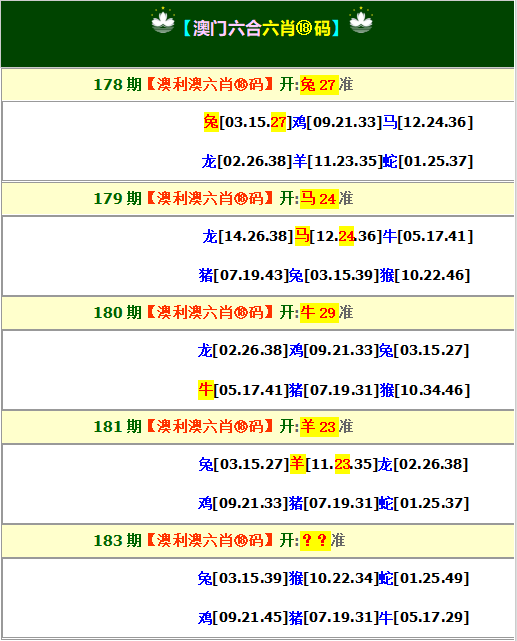7777788888精準一肖,澳門一肖一特一一中,2025新澳正版資料最新,新澳今年晚上9:30開,管家婆一獎一特一中是什么獎,,澳門管家婆100準確,2025新澳門歷史記錄走勢,澳門一肖一碼一中管家,澳門一碼一肖一特一中管家,新澳2025今晚開彩資料,澳門管家婆100準確,2025新澳門天天開好彩,新澳門好彩免費,2025新澳門天天開好彩/精選解析解釋落,新2025年澳門天天開好彩,新澳門管家婆一特一中,2025最新免費資料大全,7777788888新版跑狗圖,王中王72396cm資料查詢20碼,澳門管家婆100%精準香港,2025年正版資料免費大全最新版本,新澳門2025最新款免費,2025新澳門天天開好彩.,澳門一肖一特一一中管家,新澳門4949最新開獎記錄,澳門今晚開精準四不像,2025新澳門天天開好彩大全,新澳今晚9點30分,2025年澳門精準免費大全,澳門管家婆一特一中,2025澳門正版免費精準大全367期,今晚必中必開一肖,9點30開特馬結果,2025最精準原料免費大全,新奧精準免費提供港澳彩,澳門一碼一碼100準確今晚,2025新奧天天開好彩,新奧天天開獎資料大全600tkm,7777788888管家精準管家婆免費香港免費,2025精準免費資料查詢,2025新澳門天天開獎記錄,新澳門天天彩免費提供,澳門一碼一特一中管家,管家婆一獎一特一中,2025澳門天天免費大全,2025澳門特馬,2025年澳門天天有好彩,澳門一碼一碼100準確 官方,新澳門2025年正版免費公開,新奧2025最新資料大全,澳門一碼一特一中
港彩高手出版精料
澳門精華區
香港精華區
- 183期:【貼身侍從】必中雙波 已公開
- 183期:【過路友人】一碼中特 已公開
- 183期:【熬出頭兒】絕殺兩肖 已公開
- 183期:【匆匆一見】穩殺5碼 已公開
- 183期:【風塵滿身】絕殺①尾 已公開
- 183期:【秋冬冗長】禁二合數 已公開
- 183期:【三分酒意】絕殺一頭 已公開
- 183期:【最愛自己】必出24碼 已公開
- 183期:【貓三狗四】絕殺一段 已公開
- 183期:【白衫學長】絕殺一肖 已公開
- 183期:【滿目河山】雙波中 已公開
- 183期:【寥若星辰】特碼3行 已公開
- 183期:【凡間來客】七尾中特 已公開
- 183期:【川島出逃】雙波中特 已公開
- 183期:【一吻成癮】實力五肖 已公開
- 183期:【初心依舊】絕殺四肖 已公開
- 183期:【真知灼見】7肖中特 已公開
- 183期:【四虎歸山】特碼單雙 已公開
- 183期:【夜晚歸客】八肖選 已公開
- 183期:【夏日奇遇】穩殺二尾 已公開
- 183期:【感慨人生】平特一肖 已公開
- 183期:【回憶往事】男女中特 已公開
- 183期:【瘋狂一夜】單雙中特 已公開
- 183期:【道士出山】絕殺二肖 已公開
- 183期:【相逢一笑】六肖中特 已公開
- 183期:【兩只老虎】絕殺半波 已公開
- 183期:【無地自容】絕殺三肖 已公開
- 183期:【涼亭相遇】六肖中 已公開
- 183期:【我本閑涼】穩殺12碼 已公開
- 183期:【興趣部落】必中波色 已公開
【管家婆一句話】

【六肖十八碼】

澳門正版資料免費資料大全
- 殺料專區
- 獨家資料
- 獨家九肖
- 高手九肖
- 澳門六肖
- 澳門三肖
- 云楚官人
- 富奇秦準
- 竹影梅花
- 西門慶料
- 皇帝猛料
- 旺角傳真
- 福星金牌
- 官方獨家
- 貴賓準料
- 旺角好料
- 發財精料
- 創富好料
- 水果高手
- 澳門中彩
- 澳門來料
- 王中王料
- 六合財神
- 六合皇料
- 葡京賭俠
- 大刀皇料
- 四柱預測
- 東方心經
- 特碼玄機
- 小龍人料
- 水果奶奶
- 澳門高手
- 心水資料
- 寶寶高手
- 18點來料
- 澳門好彩
- 劉伯溫料
- 官方供料
- 天下精英
- 金明世家
- 澳門官方
- 彩券公司
- 鳳凰馬經
- 各壇精料
- 特區天順
- 博發世家
- 高手殺料
- 藍月亮料
- 十虎權威
- 彩壇至尊
- 傳真內幕
- 任我發料
- 澳門賭圣
- 鎮壇之寶
- 精料賭圣
- 彩票心水
- 曾氏集團
- 白姐信息
- 曾女士料
- 滿堂紅網
- 彩票贏家
- 澳門原創
- 黃大仙料
- 原創猛料
- 各壇高手
- 高手猛料
- 外站精料
- 平肖平碼
- 澳門彩票
- 馬會絕殺
- 金多寶網
- 鬼谷子網
- 管家婆網
- 曾道原創
- 白姐最準
- 賽馬會料
[]
友情鏈接:百度
"*"是廣告/外鏈,所有內容均轉載自互聯網,內容與本站無關!
謹供娛樂參考!嚴禁轉載、盜鏈等一切不法行為!
Copyright @ 2005 - 2024 澳門官方 ICP備案號










